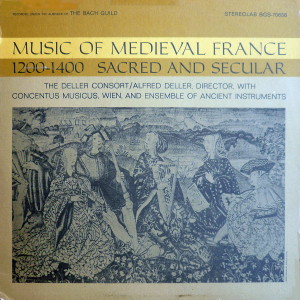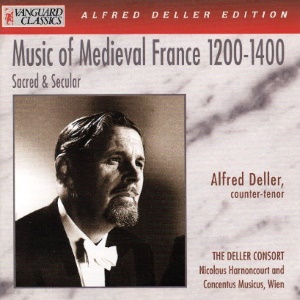 |
1 LP -
BG 656 - (p) 1964
|
 |
| 1 CD -
08 5058 71 - (c) 1995 |
|
| Music of
Medieval France 1200-1400 - Sacred
and Secular |
|
|
|
|
|
|
|
- Anonimous
(c. 1200) - Conductus, "Dic Christi
veritas"
|
|
2' 38"
|
A1 |
- Perotin (c. 1200) -
Alleluja Nativitas
|
|
6' 51" |
A2 |
- Anonimous
(c. 1200) - Conductus, "Pater noster
commiserans"
|
|
5' 31"
|
A3 |
| - Anonimous (c. 1200) -
Alleluja Christus resurgens (with
clausola, "Mors") |
|
4' 10" |
A4
|
- Anonymous (c. 1280) -
Hoquetus "in seculum"
|
|
1' 02" |
B1 |
| - Anonymous (c. 1280) -
Amor potest conqueri |
|
1' 15" |
B2 |
| - Anonymous (c. 1300) -
In seculum d'Amiens longum |
|
0' 55" |
B3 |
| - Anonymous (13th
century) - El mois de mai |
|
1' 03" |
B4 |
| - Anonymous (14th
century) - La Manfredina |
|
1' 10" |
B5 |
| - Vaillant (c. 1400) -
Par maintes foys |
|
3' 27" |
B6 |
| - Solage (c. 1400) -
Pluseurs gen voy |
|
2' 02" |
B7 |
| - Matheus de Perusio (c.
1400) - Ne me chant |
|
1' 37" |
B8 |
| - Guillaume de Machaut
(c. 1300-1377) - S'il estoit |
|
1' 54" |
B9 |
| - Guillaume de Machaut -
Comment qu'a moy |
|
1' 47" |
B10 |
| - Matheus de Perusio -
Andray soulet |
|
0' 43" |
B11 |
| - Anonymous (c. 1400) -
Or sus vous dormez trop |
|
4' 22" |
B12 |
| - Solage - Helas je voy |
|
2' 07" |
B13 |
| - Grimace (c. 1400) -
Alarme, Alarme |
|
1' 57" |
B14 |
|
|
|
|
| Side One
(A1-A4) |
Side Two
(B1-B14) |
|
|
|
|
| The
Deller Consort |
Mary
Thomas, soprano
|
|
| -
Alfred Deller, countertenor |
Alfred
Deller, countertenor
|
|
| -
Wilfred Brown, tenor |
Robert
Tear, tenor
|
|
| -
Gerald English, tenor |
|
|
| -
Maurice Bevan, baritone
|
Concentus
Musicus Wien
|
|
|
-
Alice Harnoncourt, pardessus de
viole
|
|
| -
Helmut Hucke, diskantpommer |
-
Nikolaus Harnoncourt, tenorfiedel
|
|
| -
Albrecht Renz, zink |
-
Hermann Hobarth, bassfiedel
|
|
| -
Hans-Martin Linde, recorder |
-
Jürg Schaetlein, recorders in
c', f', g' c"
|
|
| -
Johannes Koch, regal, or
portable organ |
-
Kurt Theiner, portable organ
|
|
|
-
Hans Pöttler, trombone
|
|
|
-
Leopold Stastny, recorder in f'
and percussion
|
|
|
-
Ernst Knava, percussion
(tambourin, triangle and drum)
|
|
|
Luogo e data
di registrazione
|
| 1962 |
|
Registrazione
live / studio
|
| studio |
Producer / Engineer
|
Seymour Solomon
|
Prima Edizione
CD
|
Vanguard Classics "Alfred
Deller Edition" - 08 5058 71 - (1 cd) -
45' 06" (c) 1995 - ADD
|
Prima
Edizione LP
|
- Vanguard "The Bach Guild" -
BG 656 (mono) / BGS 70656 (stereo) - (1
lp) - 45' 06" - (p) 1964
|
Note
|
Una bizzarria dell'edizione in
CD: con la medesima sigla (08 5058 71),
ne esiste una seconda versione con
diverso contenuto musicale. L'edizione
con l'immagine della copertina qui
riportata corrisponde nel contenuto
all'originaria edizione in LP. L'altra
edizione comprende il "De Profundis" di
Delalande ma non il contenuto del lato 1
dell'edizione in LP.
|
|
|
Notes on the program
|
|
This program offers a
view of the great upsurge in musical
composition in Europe between the end of
the 12th century and beginning of the
15th century. Many of the works are
anonymous. Of the composers whose names
are attached to some of them, little
else is known. Even so towering a figure
as éerotin or Perotinus, master of music
at Notre Dame in Paris from 1183, did
not sign his work, which is ascribed to
him from other sources. The one
exception is the remarkable 14th century
genius Guillaume de Machaut (c.
1300-1377), who became a famous man and
was not only composer and churchman but
poet, diplomat and friend of kings.
If historically this music represents
the first great stride in Western
musical composition, it is at the same
time a highly polished, sophisticated
and consummate art in its own right. The
religious works on Side One, which are
by Perotin or come from his age, not
only exhibit the historic development of
organized, measured rhythm but in their
powerful "cellular" construction of
repeated units and clashing contrapuntal
voices are as distinctive and com plete
an expression of their age as the Gothic
architecture of Notre Dame where they
were sung. The secular works on Side Two
are influenced by dance, as with "La
Manfredina," or represent the growth of
a finely expressive, florid
single-voiced art of song, following, as
with the ballades, rondeaux and
virelais, the complex verse forms
of amorous court poetry.
The singers are members of the famous
Deller Consort, distinguished as solo
voices, as masters of ancient styles,
and for their dedicated partecipation in
the outstanding part-song ensemble of
our time. The instrumentalists on Side
One are Helmut Hucke (Diskanpommer),
Albrecht Renz (Zink), Hans-Martin Linde
(Recorder) and Johannes Koch (Regal, or
portable organ). The instrumentalists on
Side Two, members of the Concentus
Musicus, Wien, and the instruments on
which they play, are as follows: Alice
Harnoncourt (Pardessus de Viole,
Ludovicus Guersan, Paris, 1741);
Nikolaus Harnoncourt (Tenorfiedel, North
Italy, c. 1550); Hermann Hobarth
(Bassfiedel, Stefanus de Fantis, North
Italy, c. 1550); Jürg Schaeftlein
(Recorders in c', f', g' c", copied
after 16th century originals in the
Vienna Museum); Kurt Theiner (Portable
organ, reconstruction of a Flemish
instrument of c. 1430); Hans Pöttler
(Trombone, Frederick Ehe, Nuremberg, c.
1700); Leopold Stastny (Recorder in f');
and Ernst Knava who with Leopold Stastny
plays the percussion, consisting of
Tambourine, Triangle and Drum.
Notes (BG 656 or BGS
70656)
|
|
Nikolaus
Harnoncourt (1929-2016)
|

|

|
|